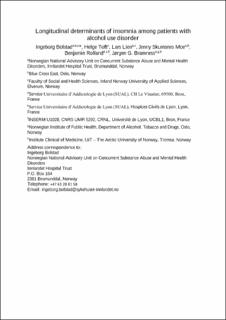| dc.description.abstract | Insomnia is common among patients with AUD and can impair quality of life and cognitive functioning, as well as cause psycho-social problems and increased risk of relapse. Nonetheless, determinants of insomnia in patients with AUD have scarcely been studied. We aimed to examine prevalence and development of self-perceived insomnia among inpatients in treatment for AUD, and to examine factors in this group known to be associated with sleep disturbance in the general population. We examined self-reported information about sleep from ninety-four AUD inpatients in long-term treatment (up to nine months) using a questionnaire identifying probable insomnia. Potential predictors identified in bivariate tests were used in binomial logistic regressions to examine the effect on sleep at baseline and at six-week follow-up. Longitudinal multilevel analyses were used to examine factors affecting development of sleep quality during the treatment stay. At baseline, 54% of the patients reported sleep problems indicating insomnia. This was reduced to 35% at six-week follow-up. In a cross-sectional analysis of sleep at baseline, we found that being male (OR 0.18, p=0.042) and engaging in physical activity (OR 0.09, p<0.001) were negatively associated with insomnia, while a high level of depressive symptoms (OR 1.10, p=0.010) was positively associated after adjustment for age, history of trauma and severity of dependence. Multilevel analyses of data over a six-month period showed time interactions with physical activity, such that sleep improvement was greater in patients who initially had a low level of physical activity. This longitudinal study corroborates findings of high prevalence of insomnia among AUD patients and identifies factors in this group associated with insomnia, such as sex, depression and physical activity. Future longitudinal studies are needed to examine the causal directions between sleep, depression, and physical activity and how these might be targeted in clinical settings. Keywords: Alcohol use disorder; depression; insomnia; physical activity; sleep. | |
